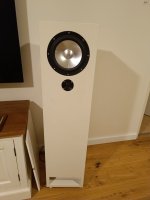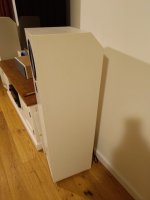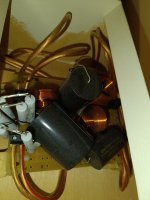Hello everyone,
I'm new to this forum.
About 10 years ago I build my first (and so far only) speakerset. Being the ambitious uni-kid that I was, I thought building a transmission line speaker was a great idea.
I was inspired by the fantastic sound of the Impulse 54 speakers and didn't even really consider any other type of enclosure.
With sufficient EQ, they don't sound terrible, but given the time, effort and money spend on them, I hope I can safe someone else's project.
The goal of this thread is to summarize some of the many mistakes I made while building them. Some specific for T-lines, others that apply to any speaker type. I have ordered them by severety of the consequences.
Only use guidelines instead of software for the design.
I remember making quite a few calculations based on the resonance of the air mass, the Fs of the driver and the quarter wave of the T-line. However, I have no documentation, so I don't know what I did exactly. I do know the calculations were based on some threads I found on a forum somewhere (not vague at all). While they might have been a good starting point for the T-line, they certainly didn't give the results anyone would be looking for. If I had taken the time to learn Hornresp to model the response, my speakers would have turned out a lot better.
There are multiple free programs available that do a lot of the calculations for you. (I mention Hornresp, because that can do the calculations for T-lines, where I am not certain if other free software can do that)
Don't document what you are doing.
10 years later, I would like to make some modifications to the speakers. It would have been really usefull if I had the internal dimensions and locations of the internal panels. It also took me some time to figure out what I did for the crossover which drivers I used.
It is likely if you are building your first speakers they are not perfect and later modifications are just a lot easier if you have all the information. And considering how long most people (myself included) will wait before actually changing them, it is unlikely you remember all the details.
Also, I have little photo's to show the people that are interested.
The worst thing I regret is that I had some measurements performed at a friend of a friend and I no longer have the results of that. I still remember some things, but details are just gone.
Focus on one speaker type.
I was fully focused on the T-line design. I did not even look what the response would be for this driver in a ported or sealed enclosure. (It turns out this driver in a ported enclosure that is 20% smaller than this enclosure would be able to play significantly lower than this design. And it would also have been a lot easier to build)
Rush during a glue-up
Glueing the T-line was quite a bit of work and at some point, I rushed too much. One panel is at a very slight angle. It took incredebly long to fix it in such a way that it was airtight and did not look badly. Many times more than it would have taken the extra 30 minutes or so to properly fix it in place during the drying.
Not knowing what baffle step is.
Due to this, I will really not be able to make these speakers sound good without EQ. It is fortunatly a relatively smooth function that can be resolved well with EQ, but some tweaks to the design could have significantly increased accuracy without EQ. (it is about 5dB louder at 1kHz than at 100Hz)
Don't match sensitivity of drivers.
Really not too much of a problem and I don't even know how I overlooked this initially. Most tweeters are significantly more sensitive than woofers. I had to add a -6dB L-pad to the tweeter after I did some measurements. Luckily the crossover still had some space left and fixing it was easy enough.
Get the wrong damping material
For a T-line, damping the low frequencies is an absolute must. I learned recently when investigating how to improve my speakers. When I build the speakers I put in sheeps wool, as that was (according the some fora) the best damping for speakers. Now I know, sheep wool doesn't do anything for the low frequencies. I would have been a lot better of with rockwool, or some other very dense and heavy damping.
Buy the thickest and "best" wood.
I made the cabinets out of 24 mm (real) berch plywood. Given the power of the drivers there is absolutely no need for this kind of stiffness. Especially considering I did also have internal bracing. With that bracing 16mm mdf would have been perfectly fine. Now my speakers weigh in at about 60 kg a piece and I spend much more money than I needed to.
Now, to round this off, I would also like to mention some things I am really glad about doing for these speakers.
Build them
So just in general the idea of having build my own speakers is great. Even though they are not as good as I had hoped, I had a lot of fun building them and the result is still okay.
Get high quality components
So there is of course a limit to what "high quality" means. But I spend so much time and effort on the speakers, I'm glad I didn't safe a few euro's on the binding posts, the screw or the paint. It also means that now I am motivated to improve these speakers as (in my opinion) they look great and with all the components there is the potential for more.
Spend time on finishing
Getting these speakers sanded down completely smooth, prime and paint them took some effort, but given how they are part of my living space, I am really happy I did spend that time. If they would have sounded awesome, but looked ugly, I am not 100% certain they would still be in my house.
I would love to hear some of the mistakes you all made. Are there some of the same mistakes? Or completely different ones?
I'm new to this forum.
About 10 years ago I build my first (and so far only) speakerset. Being the ambitious uni-kid that I was, I thought building a transmission line speaker was a great idea.
I was inspired by the fantastic sound of the Impulse 54 speakers and didn't even really consider any other type of enclosure.
With sufficient EQ, they don't sound terrible, but given the time, effort and money spend on them, I hope I can safe someone else's project.
The goal of this thread is to summarize some of the many mistakes I made while building them. Some specific for T-lines, others that apply to any speaker type. I have ordered them by severety of the consequences.
Only use guidelines instead of software for the design.
I remember making quite a few calculations based on the resonance of the air mass, the Fs of the driver and the quarter wave of the T-line. However, I have no documentation, so I don't know what I did exactly. I do know the calculations were based on some threads I found on a forum somewhere (not vague at all). While they might have been a good starting point for the T-line, they certainly didn't give the results anyone would be looking for. If I had taken the time to learn Hornresp to model the response, my speakers would have turned out a lot better.
There are multiple free programs available that do a lot of the calculations for you. (I mention Hornresp, because that can do the calculations for T-lines, where I am not certain if other free software can do that)
Don't document what you are doing.
10 years later, I would like to make some modifications to the speakers. It would have been really usefull if I had the internal dimensions and locations of the internal panels. It also took me some time to figure out what I did for the crossover which drivers I used.
It is likely if you are building your first speakers they are not perfect and later modifications are just a lot easier if you have all the information. And considering how long most people (myself included) will wait before actually changing them, it is unlikely you remember all the details.
Also, I have little photo's to show the people that are interested.
The worst thing I regret is that I had some measurements performed at a friend of a friend and I no longer have the results of that. I still remember some things, but details are just gone.
Focus on one speaker type.
I was fully focused on the T-line design. I did not even look what the response would be for this driver in a ported or sealed enclosure. (It turns out this driver in a ported enclosure that is 20% smaller than this enclosure would be able to play significantly lower than this design. And it would also have been a lot easier to build)
Rush during a glue-up
Glueing the T-line was quite a bit of work and at some point, I rushed too much. One panel is at a very slight angle. It took incredebly long to fix it in such a way that it was airtight and did not look badly. Many times more than it would have taken the extra 30 minutes or so to properly fix it in place during the drying.
Not knowing what baffle step is.
Due to this, I will really not be able to make these speakers sound good without EQ. It is fortunatly a relatively smooth function that can be resolved well with EQ, but some tweaks to the design could have significantly increased accuracy without EQ. (it is about 5dB louder at 1kHz than at 100Hz)
Don't match sensitivity of drivers.
Really not too much of a problem and I don't even know how I overlooked this initially. Most tweeters are significantly more sensitive than woofers. I had to add a -6dB L-pad to the tweeter after I did some measurements. Luckily the crossover still had some space left and fixing it was easy enough.
Get the wrong damping material
For a T-line, damping the low frequencies is an absolute must. I learned recently when investigating how to improve my speakers. When I build the speakers I put in sheeps wool, as that was (according the some fora) the best damping for speakers. Now I know, sheep wool doesn't do anything for the low frequencies. I would have been a lot better of with rockwool, or some other very dense and heavy damping.
Buy the thickest and "best" wood.
I made the cabinets out of 24 mm (real) berch plywood. Given the power of the drivers there is absolutely no need for this kind of stiffness. Especially considering I did also have internal bracing. With that bracing 16mm mdf would have been perfectly fine. Now my speakers weigh in at about 60 kg a piece and I spend much more money than I needed to.
Now, to round this off, I would also like to mention some things I am really glad about doing for these speakers.
Build them
So just in general the idea of having build my own speakers is great. Even though they are not as good as I had hoped, I had a lot of fun building them and the result is still okay.
Get high quality components
So there is of course a limit to what "high quality" means. But I spend so much time and effort on the speakers, I'm glad I didn't safe a few euro's on the binding posts, the screw or the paint. It also means that now I am motivated to improve these speakers as (in my opinion) they look great and with all the components there is the potential for more.
Spend time on finishing
Getting these speakers sanded down completely smooth, prime and paint them took some effort, but given how they are part of my living space, I am really happy I did spend that time. If they would have sounded awesome, but looked ugly, I am not 100% certain they would still be in my house.
I would love to hear some of the mistakes you all made. Are there some of the same mistakes? Or completely different ones?
Attachments
Don't use your mom's brand new Kleenex box for a speaker cab without first asking! 😳
Dad was doing 'something' under the dash of our '49 Ford on a Sunday after church and had removed the oval speaker, so just had to try it...... Got one of her patented 'Hell Fire 'n Brimstone' sermons, but also a Cub Scout Merit Badge for it when she submitted it behind my back, so that's the beginning of my 'adventures' in DIY speaker design/building.
Consequently, due to the times, most of yours don't really apply to me other than 'baffle step' (speakers always against a wall or mostly in a corner), 'thickest and best wood' since scrap from tearing down old structures, etc., were my only options other than heavy duty appliance, furniture corrugated cardboard boxes that I mostly used along with the occasional concrete block or pipe.
Finally used up what was left of the 'treated' wood for these unfinished MLTLs in 2001 (picture doesn't do them justice) and lack the tripod 'outrigger' framework floor stands nor driver facia.
Dad was doing 'something' under the dash of our '49 Ford on a Sunday after church and had removed the oval speaker, so just had to try it...... Got one of her patented 'Hell Fire 'n Brimstone' sermons, but also a Cub Scout Merit Badge for it when she submitted it behind my back, so that's the beginning of my 'adventures' in DIY speaker design/building.
Consequently, due to the times, most of yours don't really apply to me other than 'baffle step' (speakers always against a wall or mostly in a corner), 'thickest and best wood' since scrap from tearing down old structures, etc., were my only options other than heavy duty appliance, furniture corrugated cardboard boxes that I mostly used along with the occasional concrete block or pipe.
Finally used up what was left of the 'treated' wood for these unfinished MLTLs in 2001 (picture doesn't do them justice) and lack the tripod 'outrigger' framework floor stands nor driver facia.
The mistake I made with my MLTLs was that I glued them up before stuffing them, non-removable back. Then all the stuffing just fell down covering the port at the bottom, which of course interfered. I had to make acoustically transparent "baskets" and secure them to the cab walls, I guessed about 2/3 of the way down. These would catch the stuffing and hold it above and away from the port, leaving a small unstuffed volume. Reaching in there to secure it wasnt easy. I had to drill locating holes from the outside and then find them from the inside, to start a screw.
Lesson is comprehend how your stuffing is going to work before full assembly. I can still vary the stuffing density, but that requires removal of the driver (expensive), versus, say, a door in the back (piece of wood), which I did not consider in my plans. Nothin' like something being as difficult with the implementation, right out of the chute.
Lesson is comprehend how your stuffing is going to work before full assembly. I can still vary the stuffing density, but that requires removal of the driver (expensive), versus, say, a door in the back (piece of wood), which I did not consider in my plans. Nothin' like something being as difficult with the implementation, right out of the chute.


